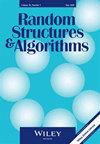Covering random graphs with monochromatic trees
IF 0.8
3区 数学
Q4 COMPUTER SCIENCE, SOFTWARE ENGINEERING
引用次数: 1
Abstract
Given an r$$ r $$ ‐edge‐colored complete graph Kn$$ {K}_n $$ , how many monochromatic connected components does one need in order to cover its vertex set? This natural question is a well‐known essentially equivalent formulation of the classical Ryser's conjecture which, despite a lot of attention over the last 50 years, still remains open. A number of recent papers consider a sparse random analogue of this question, asking for the minimum number of monochromatic components needed to cover the vertex set of an r$$ r $$ ‐edge‐colored random graph 𝒢(n,p) . Recently, Bucić, Korándi, and Sudakov established a connection between this problem and a certain Helly‐type local to global question for hypergraphs raised about 30 years ago by Erdős, Hajnal, and Tuza. We identify a modified version of the hypergraph problem which controls the answer to the problem of covering random graphs with monochromatic components more precisely. To showcase the power of our approach, we essentially resolve the 3‐color case by showing that (logn/n)1/4$$ {\left(\log n/n\right)}^{1/4} $$ is a threshold at which point three monochromatic components are needed to cover all vertices of a 3‐edge‐colored random graph, answering a question posed by Kohayakawa, Mendonça, Mota, and Schülke. Our approach also allows us to determine the answer in the general r$$ r $$ ‐edge colored instance of the problem, up to lower order terms, around the point when it first becomes bounded, answering a question of Bucić, Korándi, and Sudakov.用单色树覆盖随机图
给定一个r $$ r $$‐边‐彩色完全图Kn $$ {K}_n $$,需要多少个单色连通分量才能覆盖它的顶点集?这个自然问题是一个众所周知的经典赖泽猜想的基本等价公式,尽管在过去的50年里受到了很多关注,但仍然是开放的。最近的一些论文考虑了这个问题的稀疏随机模拟,要求覆盖r $$ r $$‐边‐彩色随机图𝒢(n,p)的顶点集所需的最小单色分量数。最近,buciki, Korándi和Sudakov建立了这个问题与30年前Erdős, Hajnal和Tuza提出的某个Helly‐型超图局部到全局问题之间的联系。我们提出了超图问题的一个改进版本,它更精确地控制了覆盖带有单色分量的随机图问题的答案。为了展示我们的方法的强大功能,我们通过展示(logn/n)1/4 $$ {\left(\log n/n\right)}^{1/4} $$是一个阈值来解决3色情况,在这个阈值处,需要三个单色分量来覆盖3边彩色随机图的所有顶点,回答了Kohayakawa, mendon a, Mota和sch lke提出的问题。我们的方法还允许我们在问题的一般r $$ r $$‐边有色实例中确定答案,直到低阶项,围绕它第一次成为有界的点,回答buciki, Korándi和Sudakov的问题。
本文章由计算机程序翻译,如有差异,请以英文原文为准。
求助全文
约1分钟内获得全文
求助全文
来源期刊

Random Structures & Algorithms
数学-计算机:软件工程
CiteScore
2.50
自引率
10.00%
发文量
56
审稿时长
>12 weeks
期刊介绍:
It is the aim of this journal to meet two main objectives: to cover the latest research on discrete random structures, and to present applications of such research to problems in combinatorics and computer science. The goal is to provide a natural home for a significant body of current research, and a useful forum for ideas on future studies in randomness.
Results concerning random graphs, hypergraphs, matroids, trees, mappings, permutations, matrices, sets and orders, as well as stochastic graph processes and networks are presented with particular emphasis on the use of probabilistic methods in combinatorics as developed by Paul Erdõs. The journal focuses on probabilistic algorithms, average case analysis of deterministic algorithms, and applications of probabilistic methods to cryptography, data structures, searching and sorting. The journal also devotes space to such areas of probability theory as percolation, random walks and combinatorial aspects of probability.
 求助内容:
求助内容: 应助结果提醒方式:
应助结果提醒方式:


